This Sunday’s Paris-Roubaix has to be the unique race on the calendar. Its cobbles are enough to make the Oude Kwaremont look new. The velodrome finish is unusual but the exceptions don’t end there, this is a race where reaching the showers has become part of the ritual. Even the name stands out, Roubaix is celebrated as a strong brand by the cycle-trade when in the reality it’s France’s poorest town and rarely something to celebrate.
The race didn’t start out this way. Like many if not most races, it was launched as a money-making publicity stunt. At the end of the 19th century Roubaix was France’s textile capital, the “Manchester of France” in relation to the bastion of Britain’s industrial revolution. Two wealthy cloth entrepreneurs put up money to fund a velodrome in Roubaix. Keen to attract crowds to the track, they hit upon the idea of a race from Paris that finished on the track, the culmination of such a long ride would occur right in front of an attendant crowd of workers who’d paid money to watch the finish.
So far so normal, it wasn’t until after the First World War that things started to change. In an account by the late Jean-Paul Brouchon, passing through the region rider Eugène Christophe proclaimed “here is the real hell of the north”. In this race won by Henri Péllisier, 40 following vehicles started but only five made it to Roubaix. We should use the term “hell” carefully, hell is the legacy of war rather than a bouncy farm track. The race wasn’t alone in riding through the area, Rouleur tells the tale of the Circuit des Champs de Bataille from 1919.
Post-war reconstruction came twice and by the 1960s Paris-Roubaix was a race that reflected modernity as cobbled roads all over Northern France were being sealed with tarmac. With growing income and improved technology it was possible to watch the race live on TV and French television deployed Robert Chapatte, apparently the first in TV sports commentary to work with co-commentator. But as exciting as the novelty might be live television only exposed the boring landscapes and the processional aspect of racing. In the past cycling had been a fine sport to read about, the mere act of riding from Paris to Roubaix was a feat to marvel at but TV required action. The organisers responded and in 1968 the start was moved to Compiègne, beginning a conceit that exists to this day: the race starts nowhere near Paris. While the main roads had been resurfaced many tracks created to haul mining equipment from site to site remained.
The son of Polish immigrants Jean Stablinksi worked below ground as a child and spent his spare time playing the accordion at weddings and parties to earn enough money from which he bought a racing bike and eventually turned pro, winning the world championships in 1962. It was “Stab” who showed the race organisers the Arenberg Forest section as they hunted for new roads to make the race more exciting. As France modernised, the race regressed to a battle across old roads and it’s this switch that’s given the course its identity. Today the route is preserved and celebrated as part of local heritage but are hidden to most who cross the region by car or train where the brick houses, electricity pylons and mining slag heaps are the only things that break the linear horizon.
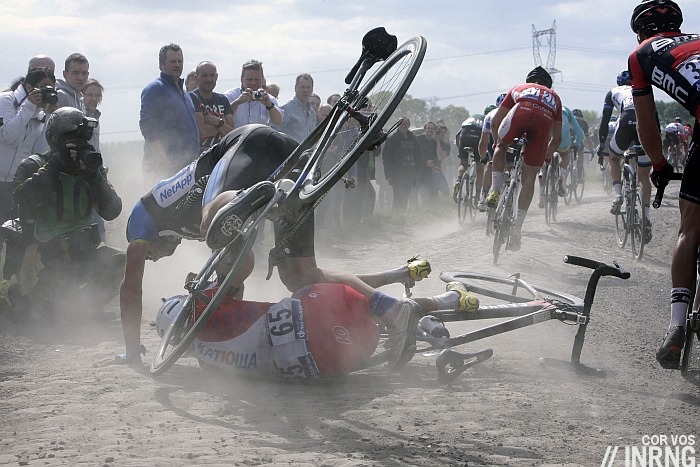
The difficulty of the cobbles makes the race a shop window for the cycle trade where the most extreme race of the year is used to sell goods for everyday use. If a bike can stand up to the cobbles then it’s strong enough to be used by weekend warriors. Carbon rims looked fragile until they passed the pavé test. It’s an old idea, the earliest bike races were marketing ploys to suggest if a bike could last a long race then it was good enough to ride to the farm or factory. Today no other race offers the same validation.
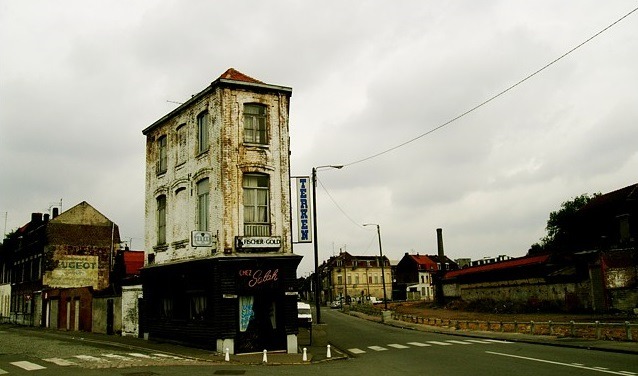
Arriving in Roubaix might be the stuff of pro cycling dreams and marketing messages but the reality is somewhat different, Roubaix has an unflattering range of socio-economic statistics and tops the list of France’s poorest towns and cities with 45% of Roubaix’s population living below the French poverty line. Added to that there’s an unemployment rate well above the national average and some of France’s highest obesity rates. The textile industry that indirectly created the race vanished long ago and the town had a sideline in mail order catalogues which have predictably been picked off by the internet. Many cyclists might long to arrive in Roubaix but many locals might dream of an opposite journey, to leave Roubaix and make it in Paris.

If cyclists long to arrive in Roubaix it’s because they’ve conquered the cobbles in a race that hurts like no other. The appeal is helped by the Roubaix velodrome which offers a victory lap for all who arrive and the strange showers inside. The original velodrome that inspired the race has been demolished and the current finish line’s future isn’t certain to remain as the new Stablinski velodrome with its indoor track and “Le Stab” makes the old track redundant. The showers are a curiosity, Paris-Roubaix is the only race where the post-race facilities are part of the legend, helped by the need to wash all that mud away when in other races a wipe with a damp cloth is enough. This is more than a washroom, it both a museum and Elysium, a resting place for heroes.
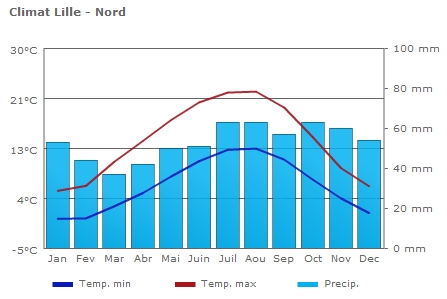
The showers are plumbed because rain showers are a rarity, curiously the race takes place at the height of the region’s dry season. It hasn’t rained since 2002 despite the surrounding Lille agglomeration being France’s 13th out of 118 for annual rainfall. The chart above is from climatedata.eu and the vertical bars are precipitation. The driest time of the year? March and April while July is the wettest which explains why it’s more likely to rain when the Tour de France visits in the summer.
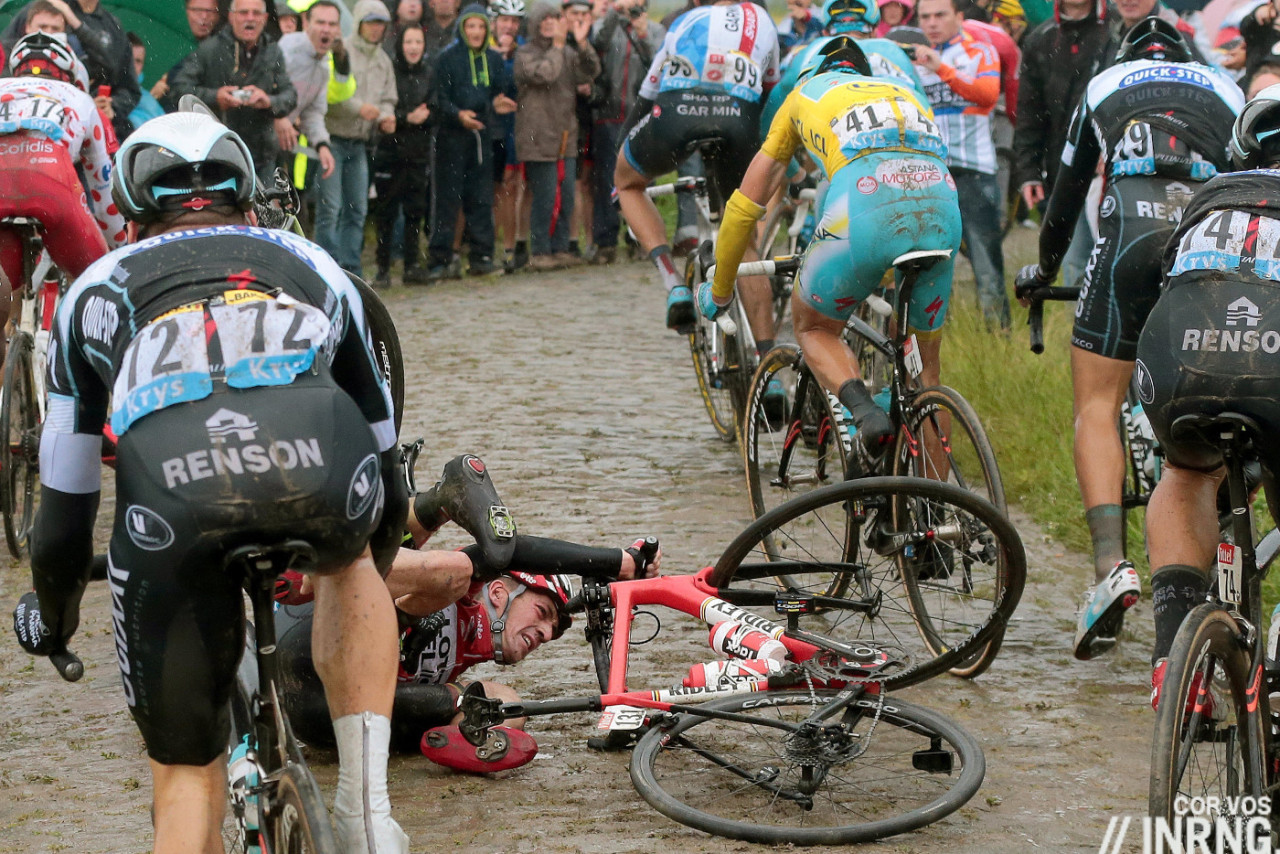
The Tour de France’s use of these roads is also a big celebration of Paris-Roubaix. Too often Le Tour obscures the rest of the sport, it is the reference point by which so many other races are judged. Yet it “borrows” the roads of Paris-Roubaix. We don’t talk about the Tour “borrowing” the roads of the Critérium du Dauphiné or the Route du Sud, in fact the Tour makes Alpe d’Huez, Mont Ventoux or the Col du Tourmalet famous. For once the Tour de France borrows its reference points from another race.
Summary
There’s no other race like it. The cobbles are special with rougher, larger stones than are typically found in a Flemish race, some competitors will arrive in Roubaix with lacerated hands and this is used to demonstrate the toughness of bicycles. It’s a race that’s unique for other reasons too, arguably one of the first bike races to bend to the TV era and seek out spectacle and today the last major race to finish on a velodrome. The sport visits for a day or maybe two if the Tour de France joins in but for the rest of the year Roubaix can be a bleak place.

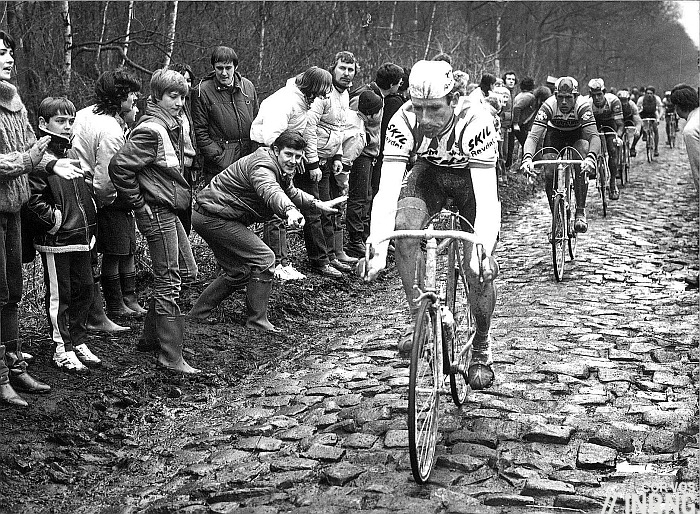
A typically beautiful piece on the race of the year (for me). Thanks as always INRNG 🙂
I’m glad somebody else has noted the incongruity between the marketing image of “epic”, “storied”, “historic” Roubaix and the reality that it is an utter hole.
I should have said “Rapha advert Roubaix”, dammit.
Does Guimard still have his office in the Velodrome?
It’s possible to have the epic race and this explains all the marketing but it’s curious to see premium bikes and products branded with a name that’s less than prestigious in France.
As for Guimard, he was running the VC Roubaix amateur team for a while – he took on a young Andy Schleck – but this has stopped to presumably the office has gone too.
But why would anyone think that when “epic” and “storied” and “historic” are used to describe Paris-Roubaix, they’re used to refer to the town? Such words refer to the race. The fact that Roubaix is rural, gritty, and hard-bitten in no way undermines the truth or the value of describing the race as epic, storied, and historic. It’s just the opposite. The day Rapha opens up a store in Roubaix is the day I start reconsidering my love for the race.
I suspect you’re pushing some ideology on us. Stop it.
My point is sort of that… What benefit does the town of Roubaix get from Specialized and the like trademarking their town and trading off the back of it?
ideology, or just unhinged rhetoric? Sorry Mr Ring.
I visited Roubaix whilst on holiday a few years ago and whilst it has obviously had a few economic problems over the years ‘utter hole’ is not a description that I would consider suitable. A quick visit around the local gallery and a chat to the locals would have brought you to a similar conclusion.
Roubaix isn’t as grim as all that sure it’s a down at heel part of northern France, it has one of the most fabulous art museums I’ve ever visited a repurposed swimming pool built for workers, the restaurant is fantastic too especially when the sun is shining and you can dine on the terrace.
It very much reminds me of the north east of England in feel, with faded industrial grandeur everywhere you look, fittingly the art gallery had an exhibition of French Industrial art featuring cockfighting and pigeon lofts very much features of County Durham. The tram is super easy to use to get to Roubaix from central Lille too, just a case of Je Bep Je Passe!
last time I was there I saw two men come to blows over the last big can of hoegaarden in a night shop.
So very much like Stockton, yes.
The museum is a special place with the way it’s built around the pool, it’s all part of the region’s bid to improve its image, the new velodrome is part of this too.
Its not the regions bid to improve its image- its the region’s bid to make it a better place to live in.
Minor gramatical point, one cannot add comparatives, superlatives or qualifiers to the word “unique”, just as you could not write that a thing is “somewhat” mortal or “extremely” infinite. A thing is either unique, like Paris Roubaix, or it isn’t, like Pinarello’s road bike with suspension.
Sorry for being a pedant but you do ask for readers to point out any typos to add a final polish to the already excellent quality of this blog.
this comment makes me happy, as modified uniqueness is one of my grammatical pet peeves. i usually use being pregnant or dead (with a wink to miracle max) as my examples. i shall steal mortal and infinite.
well done piece, however. i do love this race.
Those who are more versed in the field of mathematics know that there are many degrees of infinity. The classical example is that there is an infinite number of integers, but even more f real numbers. See the wikipedia entry on infinity, for example.
I would also argue that there are degrees of uniqueness. You could say the Ronde van Vlaanderen is unique because no other race contains 19 cobbled climbs, which is true as far as I know. But each of those climbs is also tackled in at least one other race so it isn’t nearly as unique as Paris-Roubaix which features many more unique elements.
Good to learn (especially as I know very little about mathematics).
The great thing about English is that there’s always a more apposite word or phrase. So to use the RVV example, we could say that while other one day races in Belgium use all of the cobbled bergs of the Tour of Flanders, what makes the RVV distinctive/distinguishes it from other races/ noteworthy/the event it is etc is the number of these and the race length overall. Thus the character of the event is communicated without misusing the term unique.
Apposite, as a non-native speaker I had to look that up! Great word, I’ll use it whenever it is apposite.
And as a native speaker, I had to look it up too. Where else but inrng, can one learn so much beyond merely the cycling itself? Thanks! (To the author and to the commenters)
This has been the most fun comment thread I’ve read in a while. Chapeau chaps.
All noted and yes, corrections are always welcome.
I wouldn’t have said this, but since you say ‘corrections are always welcome’:
– the one thing that seriously impacts my enjoyment of these pieces is the absence of semicolons.
It’s not that you don’t use semicolons, it’s that you create sentences with semicolons in them, but then replace them with commas when you write, which for me totally throws off the pacing and intonation in my head as I try to read. Why not just use the proper punctuation?
The rule is very simple: you can’t join two sentences with a comma and no conjunction.
So for instance when you say:
“Keen to attract crowds to the track, they hit upon the idea of a race from Paris that finished on the track, the culmination of such a long ride would occur right in front of an attendant crowd of workers who’d paid money to watch the finish”
This would conventionally be written:
“Keen to attract crowds to the track, they hit upon the idea of a race from Paris that finished on the track; the culmination of such a long ride would occur right in front of an attendant crowd of workers who’d paid money to watch the finish.”
Note that the bit before the semicolon could be a sentence and so could the bit after. Or if you’re a more oral/auditory person, the semicolon is somewhere where it’s natural to put a considerably longer and deeper pause than any old comma – there’s a bigger pause before “the culmination” than before “they hit”, isn’t there?
This can prevent misleading sentences. So in your version, it’s natural to initially read ‘the culmination of such a long ride’ as a description of ‘the track’, until suddenly you hit the ‘would’ and have to think ‘wait, woah, no, go back, oh, right, that was the subject of a new clause, got it…’ – having the semicolon there let’s people know immediately “I’ve finished saying that thing, here’s another (but closely related) thing.”
There are also a couple of times when there should be full-blown colons and you just use commas. Like it should be:
“Even the name stands out: Roubaix is celebrated as a strong brand by the cycle-trade when in the reality it’s France’s poorest town, and rarely something to celebrate.”
– the colon there is the dramatic pause of a magician before the bird flies out of his sleeve, or the comedian making you wait for the punchline. Putting in a comma instead makes it sound like you’re rushing your lines.
Using run-on sentences (i.e. using commas instead of colons, semicolons or full stops) can sometimes work powerfully to create a sense of speed, breathlessness, disorder and so on, but this (like most tricks) is only effective when used sparsely.
[There are also a couple of places where you could do with a few more commas, but that’s more legitimately an issue of style]
Anyway, like I say, I don’t normally correct people’s punctuation or writing style… but you did say that corrections were welcome. And for me, the erratic punctuation is WAY more distracting than pedantic discussions of whether things can be more or less unique than other things. [Yes, they can. The ‘things are only unique if there’s only one of them’ line is a bit trivial, because with that definition everything is completely and equally unique – everything is different somehow from everything that isn’t itself, otherwise they wouldn’t be different things. So really, ‘unique’ is about having a low level of comparability, which isn’t a binary or objective thing. On the other hand, phrases like ‘very unique’ are indeed generally not the best writing, because “unique” is already a much stronger word than the weak “very” – it’s like “quite immense” or “a little abominable” or “pleasantly orgasmic” (phrases you might certainly see, but only when someone is trying to sound flippant and amusing, because it’s hard to take them seriously), or just “very fascinating”, “very exact”, “very astonishing” and so on. The adjective is already doing all the work, so “very” is left sitting around doing nothing – sometimes it can create an ironic effect (“hmm? what? oh, yes, very terrifying, definitely. I’m petrified, honestly”), but otherwise it just lolls about flaccidly in the way of more exciting words. But this is all just a fairly trivial issue of style – you can pick apart any choice of words if you really want to.]
So yeah. English punctuation is extremely simple and easy to learn, and yet it can make things read much more instinctively, and convey much more of the writer’s spoken passion. So if you’re soliciting stylistic recommendations, my personal top request would be to use conventional punctuation. Specifically: semicolons.
[*looks embarassed*
sorry about that]
Nothing to be embarrassed about, very balanced and erudite assertion.
I realize my judgment here is controversial, but you are probably making an overcorrection, the sort of rigid application of a rule beyond its usefulness that occurs when we forget the full variety of things one can reasonably make a flexible natural language do. While it’s true that things either are or are not unique, this surely can’t prohibit our considering multiple respects of uniqueness together, such that one thing is revealed as unique in more respects than, and therefore more unique than, another. If Roubaix has a unique finish, a unique terrain, a unique level of danger, and other unique challenges, wouldn’t it have to be more unique than a race that has unique terrain, but an ordinary finish, level of danger, and set of challenges? Where ‘unique’ gets misused as a comparative is those instances where something is not meant to be called unique, but only pretty rare, and is described, say, with ‘very unique’ rather than ‘very rare’.
In The Ring’s defense, most languages — English, to be sure — are constantly evolving. That which most people currently accept is currently correct.
“. . . the unique race . . .” versus “. . . the most unique race . . .” Which sounds weirder to you? It might depend on your age.
This descent into an English grammar and punctuation lesson is hilarious. Perhaps it is “apposite” for a feature on Paris Roubaix to have a comments section which is such hard work to get through!
I wonder how many more sectors there are to go below ….
That last pic isn’t Paris-Roubaix. It’s from the Tour de France. For an article on Paris-Roubaix why not use pics from it?
To illustrate that the wettest month in the area is July, not April. Hence the photo from last year’s Tour.
That photograph is an accompaniment to the part where he writes of the Tour ‘borrowing’ the roads of Paris – Roubaix. And also the preceding part on weather conditions.
Did you not read the corresponding paragraph about how the Tour de France uses the same cobbles?
Immediately below the image:
“The Tour de France’s use of these roads is also a big celebration of Paris-Roubaix. Too often Le Tour obscures the rest of the sport, it is the reference point by which so many other races are judged. Yet it “borrows” the roads of Paris-Roubaix. We don’t talk about the Tour “borrowing” the roads of the Critérium du Dauphiné or the Route du Sud, in fact the Tour makes Alpe d’Huez, Mont Ventoux or the Col du Tourmalet famous. For once the Tour de France borrows its reference points from another race.”
I’m pretty sure Inrng would have picked up on this…What with there being the maillot jaune…….
Yes, the whole point was to use a scene from the Tour de France with the visual prompt of the yellow jersey in the shot just to help reinforce this because otherwise it would be a classic Paris-Roubaix scene, the point being to illustrate the Tour borrowing from the classic.
Aaargh! Using a name ‘Pedant’ and making such a useless comment on my favourite website! Aaargh!
We can’t all be intelligent cycling fans. At least the content is still at the usual high level.
Love this race and love this site. Thank you Inner Ring.
One of the most beautiful race of the year, for sure. Those cobbled roads are just crazy, it is not like the typical city pavé. As well, the race is normally not closed until the last kilometers as for instance the flèche wallone is.
I have discussed with people who don’t really agree with the tour going through paris-roubaix roads. As far as I am concerned I think that they are part of cycling like mountain passes or time races are. And frankly speaking, it is fun to see a Purito on those roads!!! Cannot wait to see how Quintana is dealing with them this summer!
Great piece as always, but it’s heightened my already over excited state, need to go for a ride !
Thanks very much, INRNG, one of your finest pieces in recent memory. Great stuff.
One sentence respectfully needing a bit of a fix: “The son of Polish immigrants Jean Stablinksi worked below ground as a child spend his spare time playing the accordion at weddings…”
Were the weddings underground?:)
I think your comment regarding “Hell” being the provenance of war is spot-on and shows a mature sensitivity.
On to the race! I will watch through tears, missing the injured heroes, but will hope to see new ones emerge.
Finishing at the velodrome, the riders do one and a half lap. Meaning there can be riders arriving through the gates and other riders passing after one round at the same time. Given the long history of the race, has this peculiar arrangement never caused crashes or general confusion?
I, for one, worry every year that the leader will tangle with someone entering, leaving the spoils for a surprised runner-up, much like that speed skating dude: https://www.youtube.com/watch?v=fAADWfJO2qM
Interesting note on the weather patterns, It makes me wonder about forecasts for the weekend. I saw some images of big puddles and mud earlier in the week but I imagine they will dry up without additional rainfall. Any news?
Exactly that, those big puddles have dried out. There’s the chance of a light rain shower on Saturday which if it happens will bed down the dust a bit.
One section actually had the water pumped out last Sunday. Still looks a real mudfest though. Check out this picture of Vanmarcke!
http://m.lavoixdunord.fr/sports/paris-roubaix-reconnaissance-a-quoi-ca-sert-de-gouter-ia228b47357n2763755
Is that The Cricket in the shower?
Perhaps one of the finest little pieces I’ve read here. The historical and economic contextualization was sobering and very nicely done. Chapeau bas.
I heard Boonen is riding….
No, he doesn’t.
He made a recon with his team, which increased expectation in flanders (you know, Boonen is God in Flanders, Sporza called him the “new bicycle pope” when winning his first RVV). He then stated to flemish press that he gave himself 1% probability of riding Roubaix… Which was interpreted as a almost sure ride! A few days after, he put an end to all misundertandings explaining that after a few intervals he realized that he was far from able to ride the race.
Hahahaha….
It’s been an odd story, there’s no way he’ll ride but various media sources kept referring to it. He did a recon ride with the team but this was his first ride after weeks off the bike, as if he could come back like this. To make things worse the ride was painful. He’s set to ride the Giro for the first time while team mate Cavendish won’t, he’ll do the Tour of California instead.
This comment has made me wonder whether there are rules about this. I know in other sports teams are required by the rules to declare who’ll be playing a certain amount of time before the start of the match.
Is the same true of cycling teams and races?
No, teams send a long list of riders for a race but riders can be switched until almost the last minute before the race starts. Wiggins for example wasn’t supposed to ride the classics last year but injury to Ian Stannard saw Wiggins as a late substitution for the Tour of Flanders and he went on to ride Paris-Roubaix the following week.
Every dog has its day. Roubaix gets its one fine day every year. One of the reasons cycling is such a great accessible sport making otherwise obscure locations part of the fleeting action.
Thanks for unique and wonderful overview and history of a very popular race.
Great piece on a great race. One thing that would make the race even better – reduce the number of vehicles on the course. Yes I like seeing the pictures as much as any other but it seems that there are now more vehicles than racers! In a dry year the dust clouds border on absurdity.
Great writing here! Loved this.
Now I’m even more excited for Sunday, this shall help Friday afternoon in the office fly on by!
Great piece, thanks! Despite “… where the most extreme race of the year is used to sell goods for everyday use.” I find it interesting that so many buy bicycles optimized for racing up insanely steep climbs while being followed by a support car rather than a bike similar to what’s in use at Paris-Roubaix.
Human-interest article on the volunteers who maintain the cobbled roads:
http://www.wsj.com/articles/in-france-cycling-fans-strive-to-keep-bumps-in-the-road-1428682270
In France, Cycling Fans Strive to Keep Bumps in the Road
Volunteers preserve cobblestone stretches of race route; ‘we’ll never finish our work’
As a “Brummie” I think Birmingham can claim to be the real bastion of the British industrial revolution. City of a thousand trades.
Great piece anyway as usual.
I’ll have to get another cap
Great article, INRNG, one of your finest imo.
Nice pic of Roubaix too…may it reinvent itself & rise again.
One of the things that struck me from last years tour stage was how different the countryside looked in summer vs spring. From watching the race in Australia I had become conditioned to think this part of France must be perpetually covered in stubble so it was odd to see tall wheat fields and green pastures.
A virtual INRG love fest!
Time to pony up, buy a cap if you haven’t yet.
Tommeke rides Sunday!
I might have made that last part up.
So what we can see from the list is that Roubaix is a worse place to be than Tampon.
My favourite race of the year, for all the reasons outlined. Great piece. Can’t wait!
Great piece.
Today’s exam question: Paris Roubaix: “queen of classics” or “a race for dickheads”. Discuss.
INRNG Cycling Postgraduate Coursework: Philosophy
April 2015
Major Essay Question : Is Paris-Roubaix “the queen of the classics” or “a race for dickheads”? Discuss.
Time: 45 minutes
Word Limit: 2000
Notes: extra marks are given if you have won the race
Answer:
Both. It’s bullshit.
Student: Hinault, B.
Visited Roubaix and the velodrome on a bitterly cold day last December. Walked the track (was tempted to drive it – the gate was open!). For a deadly silent concrete bowl, it shouted history. Having the wife with me meant I didn’t go searching for pavé that day…